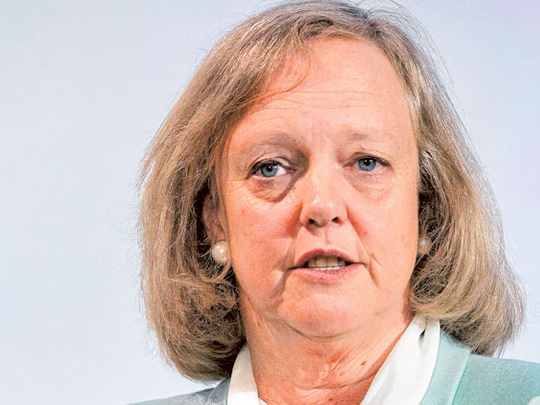
San Francisco: Hewlett-Packard Co. chief executive officer Meg Whitman is betting that refining the company’s existing strategy, rather than making radical shifts, will help reverse the fortunes of the struggling computer maker.
Whitman, a year into the CEO job, plans to sharpen the company’s focus on corporate clients with a new product lineup that includes software and tablets for businesses and a machine that combines storage, computing and networking, according to people familiar with the matter. She’ll explain her approach to analysts October 3 in San Francisco, said the people, who requested anonymity because the plans are private.
Whitman is seeking to reverse a slump that has sliced revenue for four straight quarters. Her challenge will be convincing investors that the evolutionary approach is enough to withstand threats from EMC Corp, Oracle Corp and International Business Machines Corp in the growing market for products that deliver computing over the Internet.
“There’s a huge movement toward using the cloud as the platform, and it’s going to be hard for HP to compete,” said Joshua Greenbaum, an analyst and principal of Enterprise Applications Consulting. “IBM and Oracle have made integration of hardware and software a key to their strategy.”
Whitman’s task is to shore up investors’ confidence in a company wracked by two years of management upheaval, accelerating competition and acquisitions gone awry. Whitman took the reins last September from Leo Apotheker, whose 10-month tenure was marked by strategy shifts and sales-forecast shortfalls.
Cloud Business
“They need to restructure the firm,” said Abhey Lamba, an analyst at Mizuho Securities USA Inc in New York. “All in, 80 per cent of their business could decline.”
Hewlett-Packard fell less than 1 per cent to $17.59 at the close in New York. Shares of the Palo Alto, California-based company have declined 32 per cent this year.
In its drive to help customers building out data centres to handle cloud computing, Hewlett-Packard is developing a system that combines server computers, data storage and networking components in the same device, the people said. It will run Intel Corp chips and software from such providers as IBM and SAP AG, the people said.
The approach would borrow from Hewlett-Packard’s Project Moonshot systems, which let customers cram thousands of computing cartridges into a machine to attack Web serving and data-analysis problems, the people said.
As part of the effort, the company formed an internal division, to be run by Saar Gillai, formerly vice president of cloud networking, according to a September 13 memo obtained by Bloomberg. The new unit is focused on weaving together disparate cloud-related products, according to the memo.
‘No Synergy’
While Hewlett-Packard has historically had compelling software that businesses can use to adopt cloud computing, the programs have tended to be scattered through its hardware, software and services groups, said Greenbaum of Enterprise Applications Consulting.
“There was no synergy,” he said.
The new all-in-one storage and networking devices could start at less than $100,000 and run to as high as several hundred thousand dollars as they’re expanded, one person said.
Michael Thacker, a spokesman for Hewlett-Packard, declined to comment on the memo or the October 3 analyst meeting.
Also in the works is a package of software that lets companies set up Hewlett-Packard servers, storage and networking gear with a minimum of human intervention as they build cloud- computing operations, people familiar with the project said. The idea is to capture more of businesses’ data-centre spending and escape the trap of being considered a supplier of low-cost servers, one person said.
Acquisitions Struggle
Hewlett-Packard’s growth has been trammelled as the industry’s centre of gravity shifted to mobile devices away from the personal computers at the heart of its product lineup. At the same time, the biggest builders of data centres are opting to assemble high-performance systems themselves, rather than buy them from established vendors.
Hewlett-Packard’s acquisitions haven’t always panned out either. It wrote down the value of Electronic Data Systems, acquired for $13.2 billion in 2008, and Palm, which cost $1.2 billion in 2010. Autonomy, purchased for $10.3 billion last year by Apotheker, has also been listing. Its former CEO, Mike Lynch, departed after “a significant decline in license revenue,” the company said in May.
Sales will fall about 1 per cent each of the next two years, after a 5 per cent drop this year, according to analysts’ projections compiled by Bloomberg.
“They’ve destroyed so much market value,” said Marshall, who recommends buying the shares partly on a bet that earnings have “bottomed out” this year. “They have a lot of problem areas.”
Apple, Lenovo
Whitman has already tackled some of the cost problem, cutting 29,000 jobs by the end of fiscal 2014 to save as much as $3.5 billion a year.
On the tablet front, the company is seeking to emphasise security, durability and the ability to run business applications, rather than combat Apple Inc’s iPad directly, Whitman said in an interview in August.
Competition with Apple aside, Hewlett-Packard still risks losing its lead in the PC market to Lenovo Group. Its share of PCs dropped to 14.9 per cent in the second quarter, while Lenovo’s increased to 14.7 per cent, according to Gartner Inc
Whitman will need to balance an effort to win back share with the urgency of safeguarding profitability.
Lamba said he plans to attend the analyst meeting and that he’s optimistic that Whitman “reassures us we’ve seen the bottom.”
“It’s a longer-term story,” he said. “There are no quick fixes in this situation.”











